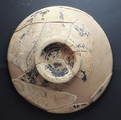VA·16
| Inscription | |
|---|---|
| Reading in transliteration: | akeśị |
| Reading in original script: | |
|
| |
| Object: | VA·16 Arsago Seprio (bowl) |
| Position: | bottom, outside |
| Orientation: | 180° |
| Direction of writing: | dextroverse |
| Script: | North Italic script (Lepontic alphabet) |
| Number of letters: | 5 |
| Number of words: | 1 |
| Number of lines: | 1 |
| Workmanship: | scratched |
| Condition: | complete, damaged |
|
| |
| Archaeological culture: | Augustan [from object] |
| Date of inscription: | late 1st c. BC [from object] |
|
| |
| Type: | unknown |
| Language: | Celtic |
| Meaning: | 'of Akeś(i)os' |
|
| |
| Alternative sigla: | Morandi 2004: 116 |
|
| |
| Sources: | Morandi 2004: 601 no. 116 |
Images
Commentary
First published in Volontè Fredini 1990: 68, 71 f.
Images in Veronesi 1990: tav. XIXe (drawing), Morandi 2001: 13, no. 6 (drawing), Morandi 2004: 603, fig. 16.116 (drawing) and tav. XVII.116 (photo).
Inscribed on the bottom of the patera (upside-down judging by the photo in Morandi). The second hasta of san and iota are damaged in the lower area, but the reading is unambiguous; both akei read by Volontè Fredini and akeni read by Solinas 1995: 348 (after the inaccurate drawing in Veronesi) can be excluded. The form can be analysed as a genitive of a masculine personal name agedos or agedi̯os (see the word page), thus the inscription documents the use of kappa for /g/ and the use of san for /d/. An unusual feature at this late period is alpha with two hastae, which may be due to influence from Latin, or merely to sloppy execution (the bar being still longer than the second hasta).



